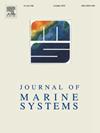Dissolved organic matter (DOM) and barium in James Bay: Distribution, sources, and climate change implications
IF 2.5
3区 地球科学
Q2 GEOSCIENCES, MULTIDISCIPLINARY
引用次数: 0
Abstract
The properties of dissolved organic matter (DOM) were examined in a dataset representative of the James Bay (Canada) marine system following two summer expeditions in 2021 and 2022. The absorption coefficients at 275 nm (a275) and 295 nm (a295) of the chromophoric DOM (CDOM) were used to establish a region-specific, usable in-depth, predictive model of dissolved organic carbon (DOC) concentration in summer, with a mean absolute percentage error of only 11 %, comparable to other models in polar environments. The DOC concentration, a350, the spectral slope between 275 and 295 nm (S275–295), the dissolved barium concentration, and four PARAFAC components (three humic-like and one protein-like) were employed as freshwater tracers. At the surface, we observed a very low DOM region in the north-west of the bay associated with the inflow of marine waters from Hudson Bay, a highly DOM-rich region in the south and east in James Bay caused by strong riverine inputs and, in the north-east, a very fresh region, but with lower DOM concentrations than to the south, induced by the discharge of the La Grande River. At depth, a homogeneous, low DOM distribution is observed in the north of James Bay, extending from east to west. In contrast, the deep water to the south is much richer in DOM and appears to circulate along the east coast. The lack of exchange at depth between the northern and southern regions is attributed to the presence of a sill that creates a physical barrier. The analysis of lignin-phenols in surface samples revealed a more “woody gymnosperm” vegetation compared to the Hudson Bay Rivers further north, which is in line with the known vegetation surrounding the Bay. The portrait of the DOM in offshore James Bay in summer thus provides a benchmark for studying the evolution of the carbon pool under climate change in this region, which is likely to undergo significant upheaval due to permafrost thaw, increased riverine inputs, and alteration of the vegetal ecosystem.
詹姆斯湾溶解有机物(DOM)和钡:分布、来源和气候变化影响
在2021年和2022年两次夏季考察之后,在具有代表性的詹姆斯湾(加拿大)海洋系统数据集中研究了溶解有机物(DOM)的特性。利用CDOM在275 nm (a275)和295 nm (a295)处的吸收系数,建立了具有区域特异性的夏季溶解有机碳(DOC)浓度深度预测模型,平均绝对百分比误差仅为11%,与极地环境下的其他模型相当。采用DOC浓度、a350、光谱斜率275 ~ 295 nm (s275 ~ 295)、溶解钡浓度和4种PARAFAC组分(3种腐殖质样和1种蛋白样)作为淡水示踪剂。在海面上,我们观察到海湾西北部的DOM非常低,这与哈德逊湾海水的流入有关;詹姆斯湾南部和东部的DOM非常丰富,这是由强烈的河流输入造成的;在东北部,一个非常新鲜的地区,但DOM浓度低于南部,这是由拉格兰德河的排放引起的。在深度上,James Bay北部呈现自东向西的均匀低DOM分布。相比之下,南部的深水区DOM含量要丰富得多,并且似乎沿着东海岸循环。北部和南部地区之间缺乏深层交流的原因是存在一个造成物理障碍的屏障。对表面样品中木质素酚的分析显示,与更北的哈德逊湾河流相比,这里有更多的“木本裸子植物”植被,这与海湾周围已知的植被一致。因此,夏季詹姆斯湾近海DOM的图像为研究该地区在气候变化下碳库的演变提供了一个基准,该地区可能因多年冻土融化、河流输入增加和植被生态系统的改变而发生重大剧变。
本文章由计算机程序翻译,如有差异,请以英文原文为准。
求助全文
约1分钟内获得全文
求助全文
来源期刊

Journal of Marine Systems
地学-地球科学综合
CiteScore
6.20
自引率
3.60%
发文量
81
审稿时长
6 months
期刊介绍:
The Journal of Marine Systems provides a medium for interdisciplinary exchange between physical, chemical and biological oceanographers and marine geologists. The journal welcomes original research papers and review articles. Preference will be given to interdisciplinary approaches to marine systems.
 求助内容:
求助内容: 应助结果提醒方式:
应助结果提醒方式:


